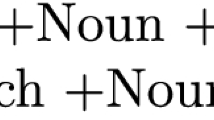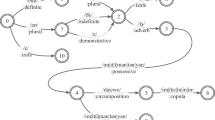Abstract
As one of the largest of the 11 official languages of South Africa, Zulu is spoken by approximately 9 million people. It forms part of a language family which is characterized by rich agglutinating morphological structures. This paper discusses a prototype of a computational morphological analyzer for Zulu, built by means of the Xerox finite state tools, in particular lexc and xfst. In addition to considering both the morphotactics and the morphophonological alternation rules that apply, the focus is on implementation and other issues that need to be resolved in order to produce a useful software artefact for automated morphological analysis. The current status of the prototype is alluded to by providing morphological scope, that is the various word categories (parts of speech) that may be handled, and the lexical coverage in terms of the number of different Zulu roots that are included in the embedded lexicon of the analyzer. Preliminary testing and validation procedures are briefly discussed.
Similar content being viewed by others
References
Jens. Allwood Grönqvist. Leif A.P. Hendrikse (2003) ArticleTitle‘Developing a Tag Set and Tagger for the African Languages of Southern Africa with Special Reference to Xhosa’ Journal of Southern African Linguistics and Applied Language Studies 21 223–237
Ken. Beesley Karttunen Lauri (2003) Finite-state Morphology CSLI Publications Stanford, CA
Erjavec, Tomaž (ed.): (2004), The MULTEXT-East Morphosyntactic Specifications Version 3.0, available at http://nl.ijs.si/ME/V3/msd/msd.pdf, accessed 14/10/2004.
A. Hurskainen (1992) ArticleTitle‘A Two-Level Formalism for the Analysis of Bantu Morphology: An Application to Swahili’ Nordic Journal of African Studies. 1 87–122
Karttunen Lauri. (2003). ‘Computing with Realizational Morphology’, in Alexander Gelbukh (ed.), Computational Linguistics and Intelligent Text Processing, 4th International Conference, CICLing 2003, Mexico City, Mexico, Lecture Notes in Computer Science 2588, Berlin; Springer, pp. 203–214.
L. Karttunen K. Oflazer (2000) ArticleTitle‘Introduction to the Special Issue on Finite-State Methods in NLP’ Computational Linguistics 26 1–2 Occurrence Handle10.1162/089120100561593
McEnery, Tony, Lou Burnard, Andrew Wilson and Baker [sic]: (1998), Validation of Morphosyntactic Analyses, available at http://www.elra.info/services/valid/wp3/MORPH.htm, accessed on 10/3/2003.
C. Meinhof (1932) Introduction to the Phonology of the Bantu Languages Dietrich Reimer/Ernst Vohse Berlin
Oflazer, Kemal and Sharon Inkelas: (2003), ‘A Finite-State Pronunciation Lexicon for Turkish’, in Proceedings of the Workshop on Finite-state Methods in Natural Language Processing, 10th Conference of the European chapter of the Association for Computational Linguistics, Budapest, Hungary, pp. 11–18.
G. Poulos C.T. Msimang (1998) A Linguistic Analysis of Zulu Via Afrika Pretoria
R. Schach Steven (2002) Object-oriented and Classical Software Engineering EditionNumber5 McGraw Hill Boston
Silberztein, M.: (1999), ‘INTEX 4.1 for Windows:a Walkthrough’, in J. M. Champarnaud, D. Maurel and D. Ziadi (eds), Automata Implementation, Third International Workshop on Implementing Automata, WIA’98, Rouen, France, Lecture Notes in Computer Science 1660, Berlin: Springer, pp. 230–243.
Sproat, Richard: (2003), Lextools: a toolkit for finite-state linguistic analysis, AT&T Labs-Research, available online at http://www.research.att.com/sw/tools/lextools/, accessed 3/10/2003.
Talmon, Rafi and Shuly Wintner: (2003), ‘Morphological Tagging of the Qur’an’, in Proceedings of the Workshop on Finite-state Methods in Natural Language Processing, 10th Conference of the European Chapter of the Association for Computational Linguistics, Budapest, Hungary, pp. 67–74.
Úi Dhonnchadha, Elaine: (2003), ‘Finite-State Morphology and Irish’, in Proceedings of the Workshop on Finite-state Methods in Natural Language Processing, 10th Conference of the European Chapter of the Association for Computational Linguistics, Budapest, Hungary, pp. 43–50.
Van Noord, G.: (2002), FSA6.2xx: Finite State Automata Utilities, available online at http://odur.let.rug.nl/~vannoord/Fsa/fsa.html, accessed 3/10/2003.
Author information
Authors and Affiliations
Corresponding author
Rights and permissions
About this article
Cite this article
Pretorius, L., Bosch, S.E. Finite-State Computational Morphology: An Analyzer Prototype For Zulu. Mach Translat 18, 195–216 (2003). https://doi.org/10.1007/s10590-004-2477-4
Published:
Issue Date:
DOI: https://doi.org/10.1007/s10590-004-2477-4




